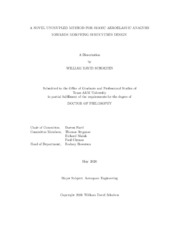| dc.contributor.advisor | Hartl, Darren | |
| dc.creator | Scholten, William David | |
| dc.date.accessioned | 2021-01-07T16:32:58Z | |
| dc.date.available | 2022-05-01T07:13:40Z | |
| dc.date.created | 2020-05 | |
| dc.date.issued | 2020-04-16 | |
| dc.date.submitted | May 2020 | |
| dc.identifier.uri | https://hdl.handle.net/1969.1/191858 | |
| dc.description.abstract | Fluid-structure interaction (FSI) analysis is a common tool used to analyze aeroelastic problems. The traditional FSI scheme couples independent structure and fluid solvers in space and time. For many aerospace applications the final equilibrium configuration of the structure is of interest, which can only be obtained by incrementally iterating the fluid and structure solvers until convergence is obtained in time, resulting in a computationally expensive process. This work develops a new method for conducting FSI analysis that greatly expedites design studies. This new scheme, referred to as the uncoupled static aeroelastic analysis (SAA) method, removes the necessarily serial interaction of the structure and fluid solvers. Instead of running a single serially coupled analysis, the uncoupled SAA method evaluates many decoupled structural and fluid analyses for given displacement and pressure fields, these evaluations being highly parallelizable. Surrogate modeling of the results from these two evaluation classes allows an interpolative calculation of their intersection; this is proposed to represent the solution of the coupled FSI analysis. This method of conducting aeroelastic analysis allows for extensions of obtaining aeroelastic solutions for multiple flow velocities without requiring further simulations, and predicting the dynamic loaded free response characteristics and divergence of the structure. This work finds that the proposed uncoupled SAA method results in accurate solutions for a range of aeroelastic problems. Additionally, this work develops an optimization scheme incorporating the uncoupled SAA method and finds that the capability to retain data sets significantly reduces computational expense associated with performing many aeroelastic analyses, enabling new possibilities for aero-structural design. | en |
| dc.format.mimetype | application/pdf | |
| dc.language.iso | en | |
| dc.subject | Fluid-Structure Interaction | en |
| dc.subject | Optimization | en |
| dc.subject | Aerostructures | en |
| dc.title | A Novel Uncoupled Method for Static Aeroelastic Analysis Towards Morphing Structures Design | en |
| dc.type | Thesis | en |
| thesis.degree.department | Aerospace Engineering | en |
| thesis.degree.discipline | Aerospace Engineering | en |
| thesis.degree.grantor | Texas A&M University | en |
| thesis.degree.name | Doctor of Philosophy | en |
| thesis.degree.level | Doctoral | en |
| dc.contributor.committeeMember | Strganac, Thomas | |
| dc.contributor.committeeMember | Malak, Richard | |
| dc.contributor.committeeMember | Cizmas, Paul | |
| dc.type.material | text | en |
| dc.date.updated | 2021-01-07T16:32:59Z | |
| local.embargo.terms | 2022-05-01 | |
| local.etdauthor.orcid | 0000-0001-6373-6857 | |


